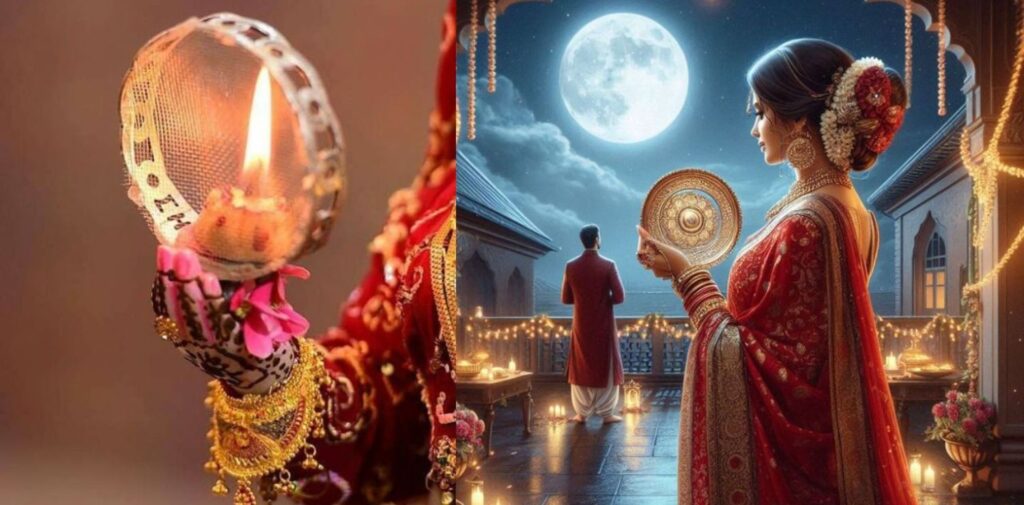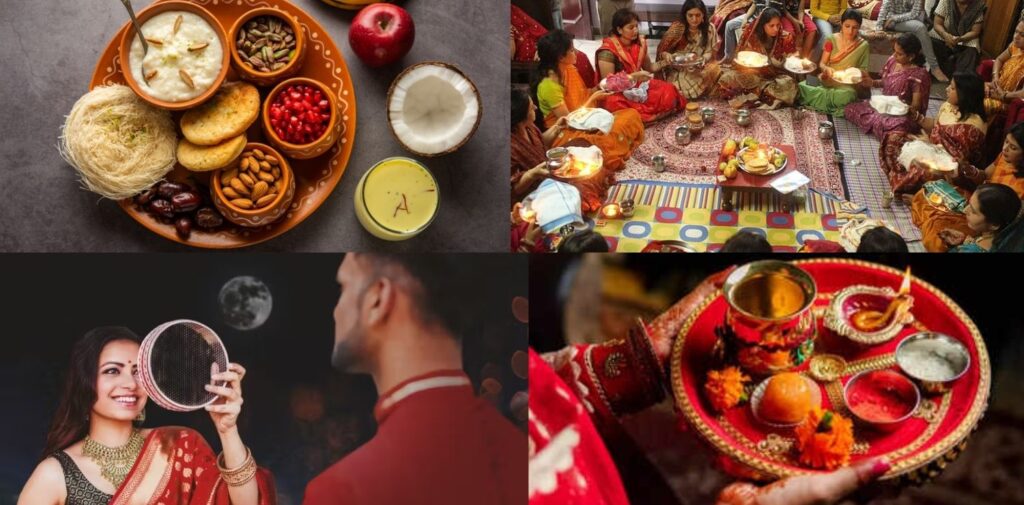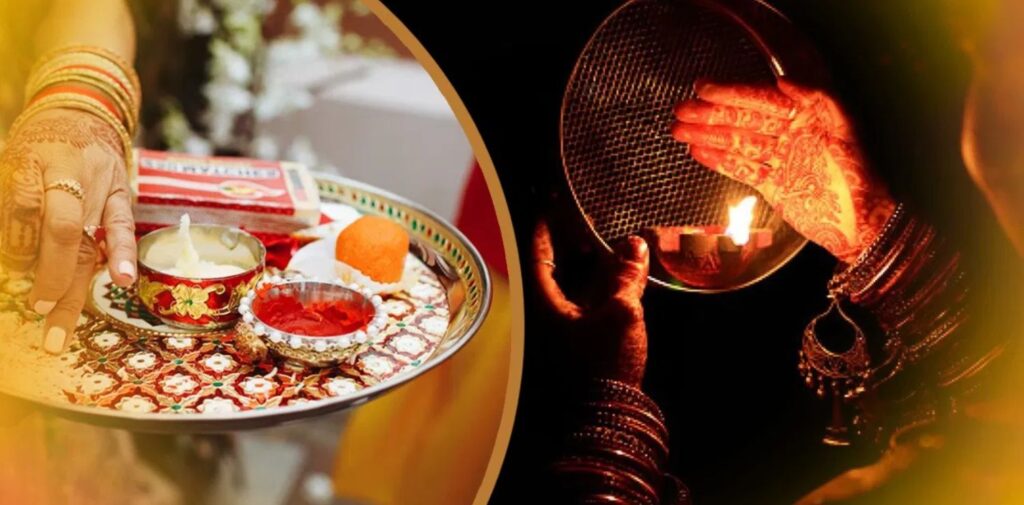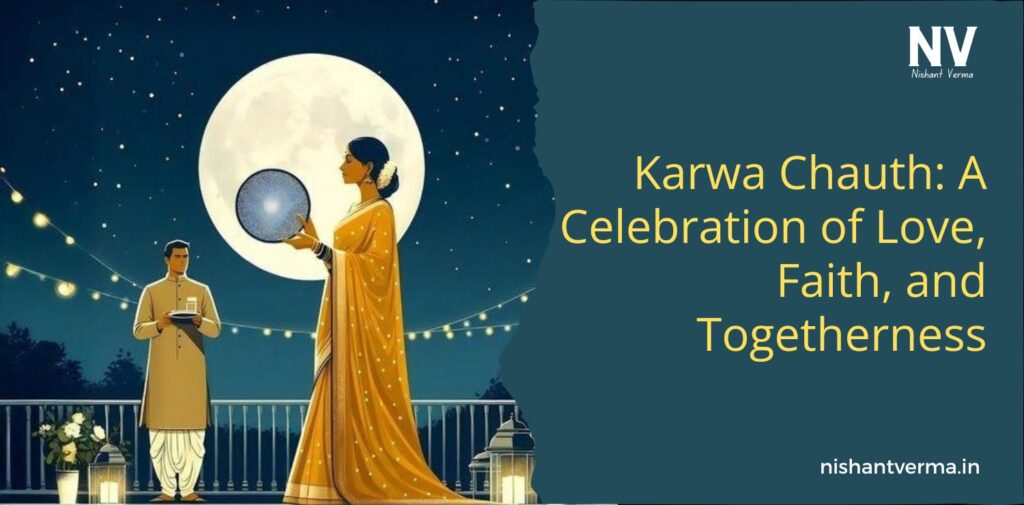Introduction: The Essence of Karwa Chauth
Karwa Chauth is a widely celebrated festival in India, predominantly among married women. It holds a significant place in the cultural traditions of northern India, especially in states like Punjab, Haryana, Rajasthan, Uttar Pradesh, and Madhya Pradesh. The festival is a day-long fast observed by married women for the well-being, prosperity, and long life of their husbands. This Festival is a perfect blend of devotion, love, and spiritual significance, often marked by beautiful rituals and customs.
The Meaning Behind Karwa Chauth
The name “Karwa Chauth” has two components: Karwa, meaning a small earthen pot, and Chauth, which stands for the fourth. The festival is observed on the fourth day of the Krishna Paksha (waning moon) in the Hindu month of Kartik (usually in October or November). The Karwa, or earthen pot, symbolizes prosperity and is used in prayers and rituals throughout the day.
Though the core of Karwa Chauth revolves around the bond between husband and wife, it is also seen as a day for women to celebrate their strength, love, and self-discipline. The fast is considered one of the toughest as women refrain from both food and water from sunrise to moonrise.

Historical Background: Where Did Karwa Chauth Begin?
The origins of Karwa Chauth are rooted in ancient Indian history, with various legends and stories offering insight into the significance of the festival.
The Legend of Queen Veeravati
One of the most famous stories associated with Karwa Chauth is that of Queen Veeravati. According to the tale, Veeravati was a devoted wife and the only sister to seven loving brothers. On her first Karwa Chauth after marriage, she was at her parents’ house and began her fast at dawn. By evening, Veeravati became weak and hungry. Her brothers, worried about her health, tricked her into believing that the moon had risen by reflecting a mirror through a tree’s branches.
Veeravati broke her fast, but soon after, she learned that her husband had fallen ill. Distraught, she prayed to Goddess Parvati, who appeared before her and instructed her to complete the fast with true devotion and sincerity. Veeravati followed the goddess’s instructions, and her husband was restored to health.
This story emphasizes the power of love, prayer, and a woman’s strength, which is why many women still fast with deep devotion for their husbands’ long life and prosperity.
The Legend of Karva
Another popular legend speaks of a devoted wife named Karva, who once saved her husband from the clutches of a deadly crocodile using her devotion and prayers. When the crocodile dragged her husband into the river, Karva bound the animal with cotton yarn and prayed fervently to Lord Yama (the god of death). Impressed by her devotion, Yama banished the crocodile to death and blessed Karva’s husband with a long life. Since then, the day has been celebrated in honor of Karva’s love and dedication, further highlighting the strength of a wife’s love for her husband.
The Significance of Fasting on Karwa Chauth
The fast observed is an integral part of the celebration. For many, it goes beyond mere tradition, symbolizing a woman’s dedication and self-sacrifice for her husband’s well-being. The fast is seen as a way to strengthen the marital bond and invoke divine blessings for a prosperous and long married life.
In addition to its spiritual meaning, Karwa Chauth also promotes self-discipline. Women exhibit patience, endurance, and control throughout the day, which are considered key virtues in Indian culture.
The Rituals and Customs of Karwa Chauth
The rituals begin early in the morning before sunrise. Here’s how the day unfolds:
Sargi – The Pre-Dawn Meal: The day starts with sargi, a special meal prepared by the mother-in-law, which is consumed by the fasting women before sunrise. Sargi typically consists of fruits, dry fruits, sweets, and traditional dishes. This meal is important as it provides strength for the long day ahead. Mothers-in-law also gift their daughters-in-law new clothes, jewelry, and other items as a mark of love and blessings.
Fasting: From the moment the sun rises until the moon appears in the night sky, women refrain from consuming any food or water. This strict fast is observed with unwavering devotion and faith. Throughout the day, women dress up in their finest traditional attire, often wearing red or bright-colored saris, bangles, and jewelry.

Puja and Karwa Chauth Story: In the evening, women gather for a special puja (prayer) where they sit in a circle with their Karwas (earthen pots) and pass them around while reciting traditional stories and prayers. The most common story narrated during the puja is that of Queen Veeravati and her devotion to her husband. Women also pray to Goddess Parvati and Lord Shiva, seeking blessings for their husbands’ long life.
Moonrise and Breaking the Fast: The climax of Karwa Chauth is the sighting of the moon, which signifies the end of the fast. Once the moon is visible, women look at it through a sieve and then turn to look at their husbands through the same sieve. This is followed by a special prayer for the husband’s well-being, and the husband feeds his wife the first sip of water and a bite of food, symbolizing the breaking of the fast.
The Modern Celebration of Karwa Chauth
While the essence of Karwa Chauth remains unchanged, the way it is celebrated has evolved over the years. In urban areas, the festival has taken on a more glamorous touch, with women participating in festive gatherings, exchanging gifts, and indulging in elaborate beauty treatments to look their best. In recent years, some husbands have also started fasting alongside their wives to show solidarity and love.
Social media platforms are flooded with pictures of couples celebrating Karwa Chauth, turning it into a festival of togetherness, romance, and companionship. Bollywood movies and TV shows have further popularized the festival, showcasing it as a symbol of love and devotion between couples.

Criticisms and Changing Perspectives
While Karwa Chauth is a beloved tradition for many, it has also faced criticism for promoting patriarchal norms. Critics argue that the festival places the responsibility of a husband’s well-being solely on the wife, reinforcing gender roles. Some modern couples, however, have reshaped the festival to make it more inclusive, with both partners fasting for each other’s long life.
Conclusion: The Lasting Significance of Karwa Chauth
Karwa Chauth is more than just a day of fasting; it is a celebration of love, faith, and togetherness between a husband and wife. The festival fosters a sense of unity, not just between couples, but also within families and communities, as women come together to share their devotion and strength.
At its core, Karwa Chauth is a reminder of the power of love, prayer, and sacrifice, qualities that continue to resonate deeply in Indian culture today. Whether observed in its traditional form or adapted to modern values, the essence of this festival remains timeless: the celebration of enduring love and partnership.



